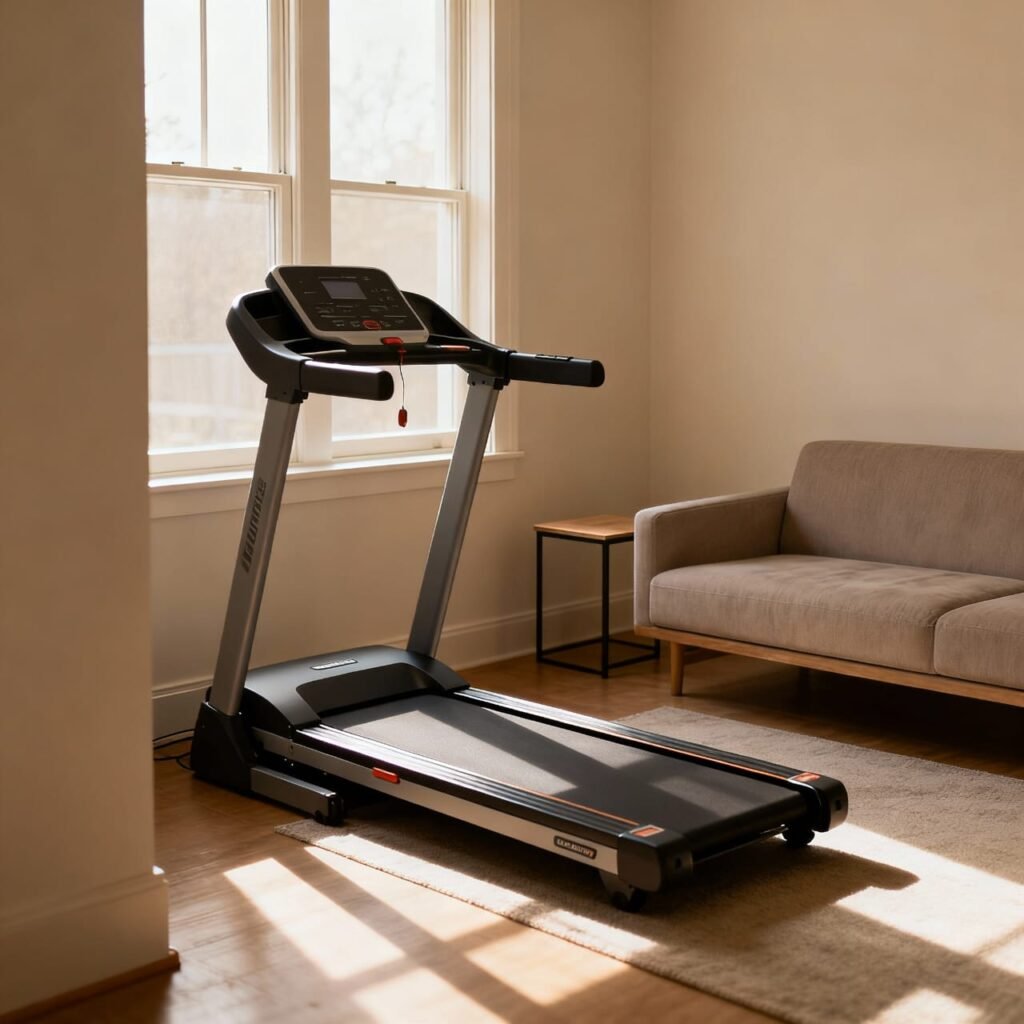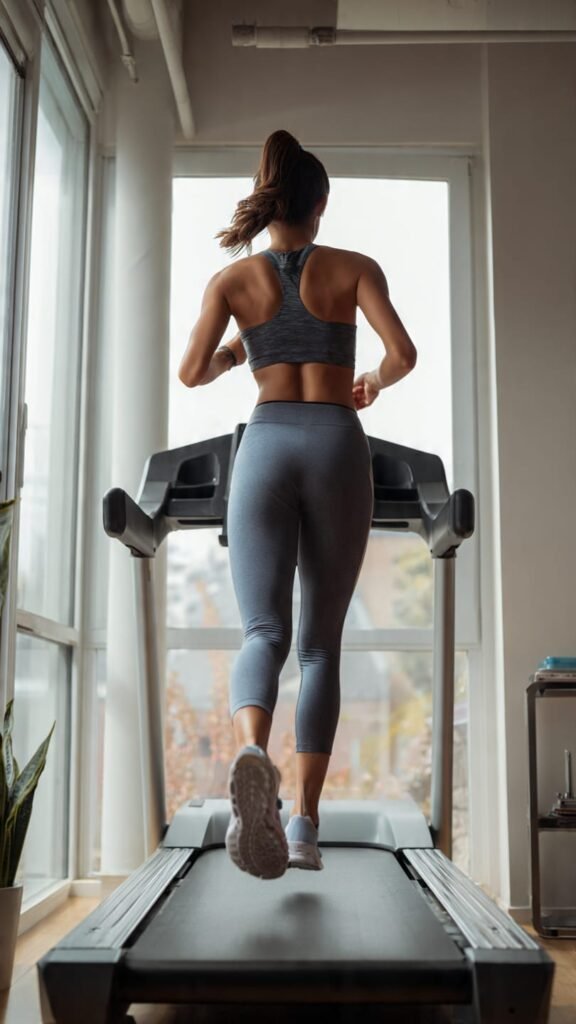- A home treadmill supports your fitness journey in more ways than you expect:
- Features to consider when buying a home treadmill
- Will home treadmill make much noise?
- Bonus: Home Treadmill vs. Other Cardio Equipment
- Home treadmill buying guide – Conclusion
These days, more and more people are eager to start running, but for those living in busy cities, road running isn’t always practical. And with busy lives and unpredictable schedules, committing to regular gym visits becomes even harder. That’s where a home treadmill stands out as a flexible and empowering option. It offers an accessible way to begin your running journey – one that fits seamlessly into your lifestyle.
A home treadmill supports your fitness journey in more ways than you expect:
- No need to scout for safe running routes – Run comfortably at home, free from the unpredictability of road traffic and terrain.
- All-weather companion – Rain or shine, your treadmill is ready whenever you are.
- A shared resource benefitting the whole family – Everyone at home can benefit with a treadmill, helping build a culture of movement and health at home.
- No dodging potholes or uneven surfaces – Enjoy smooth and consistent strides without watching your step.
- Run on your schedule – Perfect for irregular routines. Whether it’s early morning or late evening, your treadmill is always available.
- Supports weight loss and overall health – A sustainable cardio option that fits into your daily life.
- Saves time – No commute to a running spot or gym – just step on and get started at home.
- Affordable and accessible – Home treadmills are budget-friendly and available in a wide range of price points.
- Space-saving designs – Many models come with fold up design, making them ideal for compact homes.
- Engaging features – Modern treadmills often include interactive screens and smart integrations like Bluetooth pairing to make your sessions fun and motivating.

With so many types of treadmills available online and in showrooms, choosing the right one for your needs and budget can feel overwhelming. Let me help you make confident and informed buying choices. In this home treadmill buying guide, we’ll walk through the key factors to consider when selecting the ideal running machine for your space, goals, and lifestyle.
Features to consider when buying a home treadmill
1) Motor power
One of the most important factors to consider is the motor strength. Treadmill motors are typically rated in horsepower (HP) or continuous horsepower (CHP). Choose the motor capacity based on your intended usage:
- 2.0 CHP – Ideal for light walking or occasional jogging
- 2.5 CHP – Suitable for regular jogging
- 3.0 CHP – Best for consistent running routines
- 4.0+ CHP – Recommended for long-distance runs, high-speed workouts, and frequent use
2) Running Area
Ergonomics matter. The running deck size affects comfort and stride length. Most treadmills offer dimensions like 4.5 ft x 1.8 ft or 5.0 ft x 2.0 ft.
- If you’re under 6 ft tall, a 4.5 ft deck is usually sufficient
- If you’re taller or have a longer stride, opt for a 5.0 ft deck for better comfort
3) Machine features and adjustability
Look for features that support workout variety and comfort:
- Incline settings for uphill training
- Max speed for performance and safety
- Maximum weight carrying capacity as per the user needs.
- Pre-programmed modes for training on interval and threshold runs.
Modern treadmills also offer entertainment upgrades:
- Bluetooth speakers for listening to music or podcasts while walking or running
- Interactive screens that simulate scenic trails, helping reduce monotony and boost motivation
4) Treadmill size and Placement
Before buying, decide where the treadmill will go.
- Allow at least 1 meter of clearance on all sides for safety and airflow
- Use floor mats to absorb sweat and protect flooring
- Ensure there’s a plug point within 1 meter or have an electrician install one
- If the room lacks AC, ensure proper ventilation – cardio workouts generate heat and sweat
For example, a treadmill with 5.0 ft x 2.0 ft dimensions needs a space of around 3.5 ft x 4.0 ft. - Also consider folding deck designs – they’re great for saving space when not in use

5) Track cushioning
Shock absorption is key, especially if you have joint concerns.
- Look for treadmills with mid-deck padding to reduce impact on knees, ankles, and hips
- Advanced cushioning systems can make a big difference in long-term comfort and injury prevention
6) The treadmill console
The console is the control center of your home treadmill. It should allow you to adjust speed and incline, and display key metrics like pulse rate, calories burned, and workout duration.
- Most consoles include preset programs for interval training, endurance runs, and performance tracking.
- Modern models offer interactive training tools, progress dashboards, and even virtual coaching.
- Some consoles connect to global fitness communities, letting you run real-world routes and stay motivated with social support.
7) Brand reputation and after-sales support
Just like any product purchase, it’s wise to choose a treadmill from a trusted brand.
- Reputable brands offer reliable customer service, warranty coverage, and easy access to spare parts.
- Many top manufacturers provide online support portals that respond within 48 hours.
- If you are buying online, always check customer reviews and ratings to ensure quality and service standards.
8) Budget and price comparison
Once you’ve defined your needs, set a realistic budget.
- Lower-priced models are great for walking and light jogging.
- Mid-range options offer better durability and features for regular use.
- Premium home treadmills include advanced tech, better cushioning, and multi-user support.
Don’t just go for the cheapest option – compare features, build quality, and long-term value to find the best fit for your goals.
9) Safety and Injury Prevention
Treadmills offer joint-friendly movement, especially valuable for adults 40+.
- They provide low impact running compared to outdoor surfaces
- Key safety features include handrails, emergency stop buttons, and speed/incline controls accessible from the handrail
Always include warm-up routines and post-run cooldowns – they’re essential for improving performance and injury prevention.
10) Delivery, Assembly & Warranty
Before you buy, check the logistics and support offered by the seller:
- What is the delivery timeline?
- Will a technician visit your home for unboxing and assembly?
- Review warranty terms, especially for motor, frame, and electronics – and check if parts replacement is covered.

Will home treadmill make much noise?
Yes, some noise is inevitable due to the moving belt and foot impact. Most treadmills produce between 42 to 57 decibels, which is comparable to conversational speech. However, you can minimize noise with a few smart strategies:
- Routine maintenance – Keep the machine well serviced to ensure smooth operation
- Lubricate the belt regularly – Reduces friction and mechanical noise
- Use a mat or carpet – Helps absorb vibrations and dampen sound
- Install on shock-absorbing flooring – Ideal for upper-floor setups or shared spaces
Bonus: Home Treadmill vs. Other Cardio Equipment
If you’re still weighing your options for cardio workout setup at your home, this quick comparison can help you feel confident about choosing a treadmill over other popular home cardio machines:
| Equipment | Best For | Space Needs | Impact Level | Engagement |
| Treadmill | Running / Walking | Medium | Moderate | High (especially with screens and virtual routes) |
| Elliptical | Low-impact cardio | Medium | Low | Moderate |
| Stationary Bike | Seated cardio | Low | Low | Moderate |
Home treadmill buying guide – Conclusion
Whether you’re just starting out or upgrading your home gym setup, the right treadmill can transform your fitness journey. Use this guide to compare features, match your goals, and make a confident, informed decision
Choosing the right home treadmill means balancing size, motor power, ergonomics, adjustability, features, and budget. Look for essentials like deck length, incline options, and smart technologies such as virtual coaching.
Research brand reputation, check customer reviews, and ensure the treadmill suits your space and noise preferences. A well-chosen treadmill doesn’t just support your fitness; it transforms your workout experience and helps you stay consistent, motivated, and injury-free. You may also be interested in reading our blog post on Common Running Injuries After 40 and How to Avoid Them.